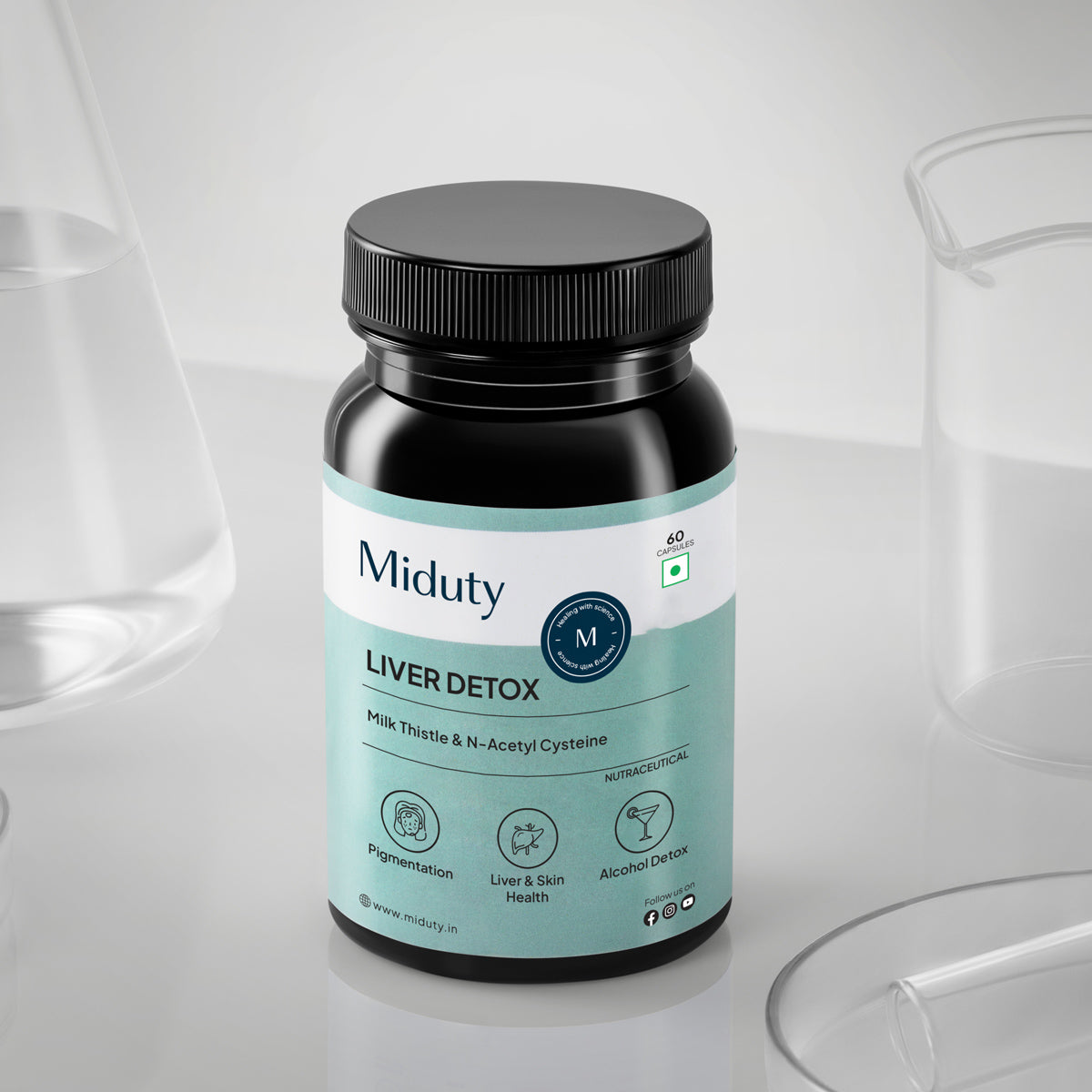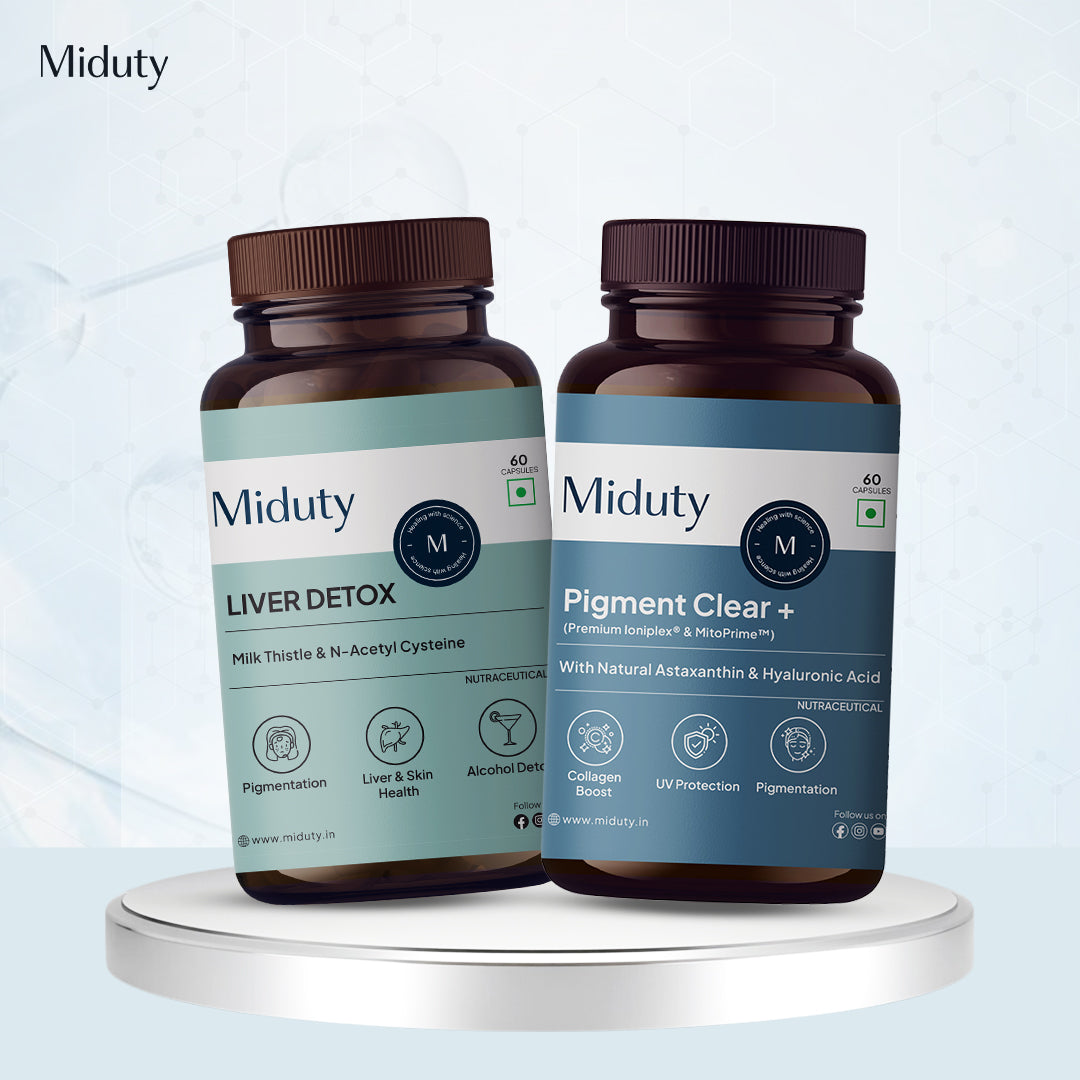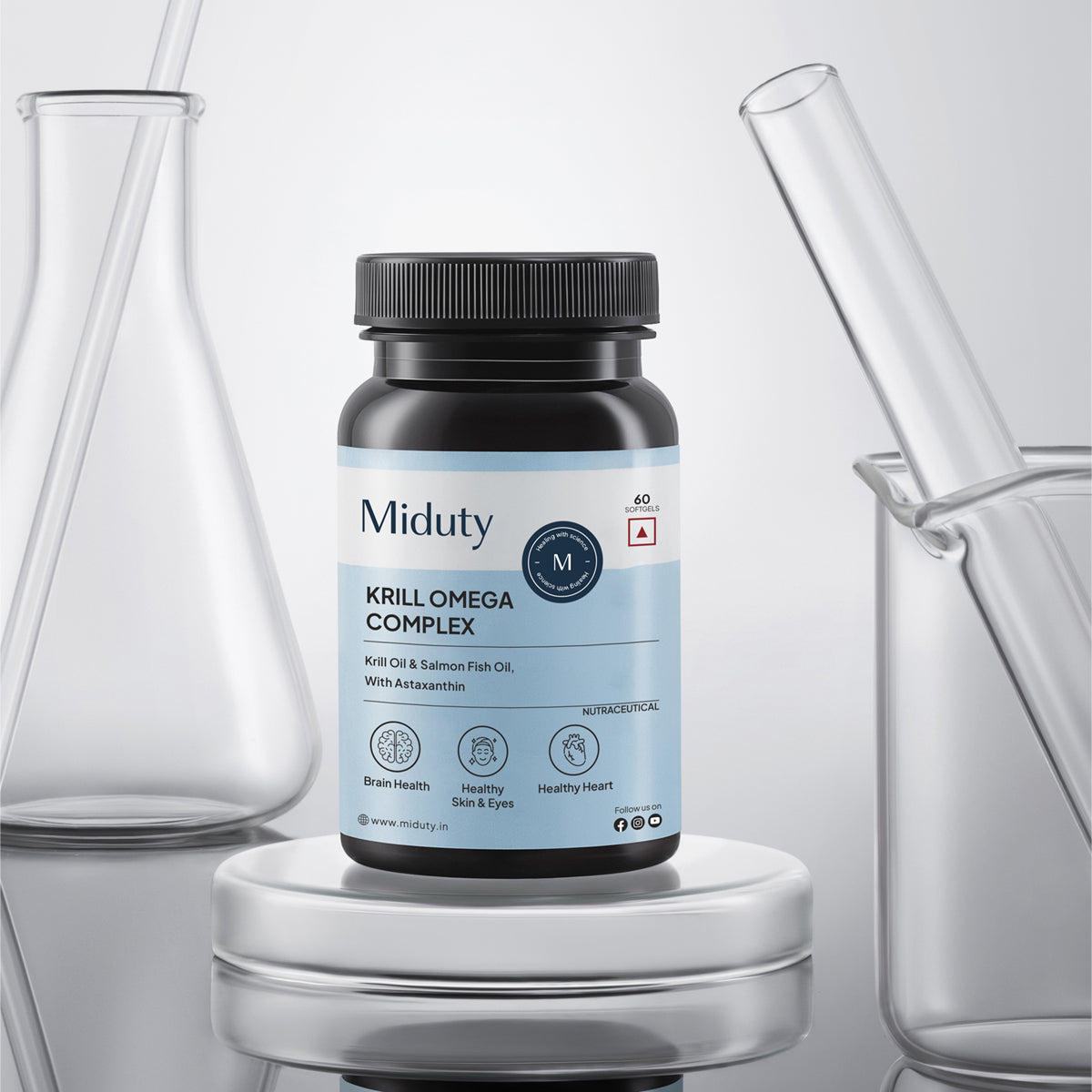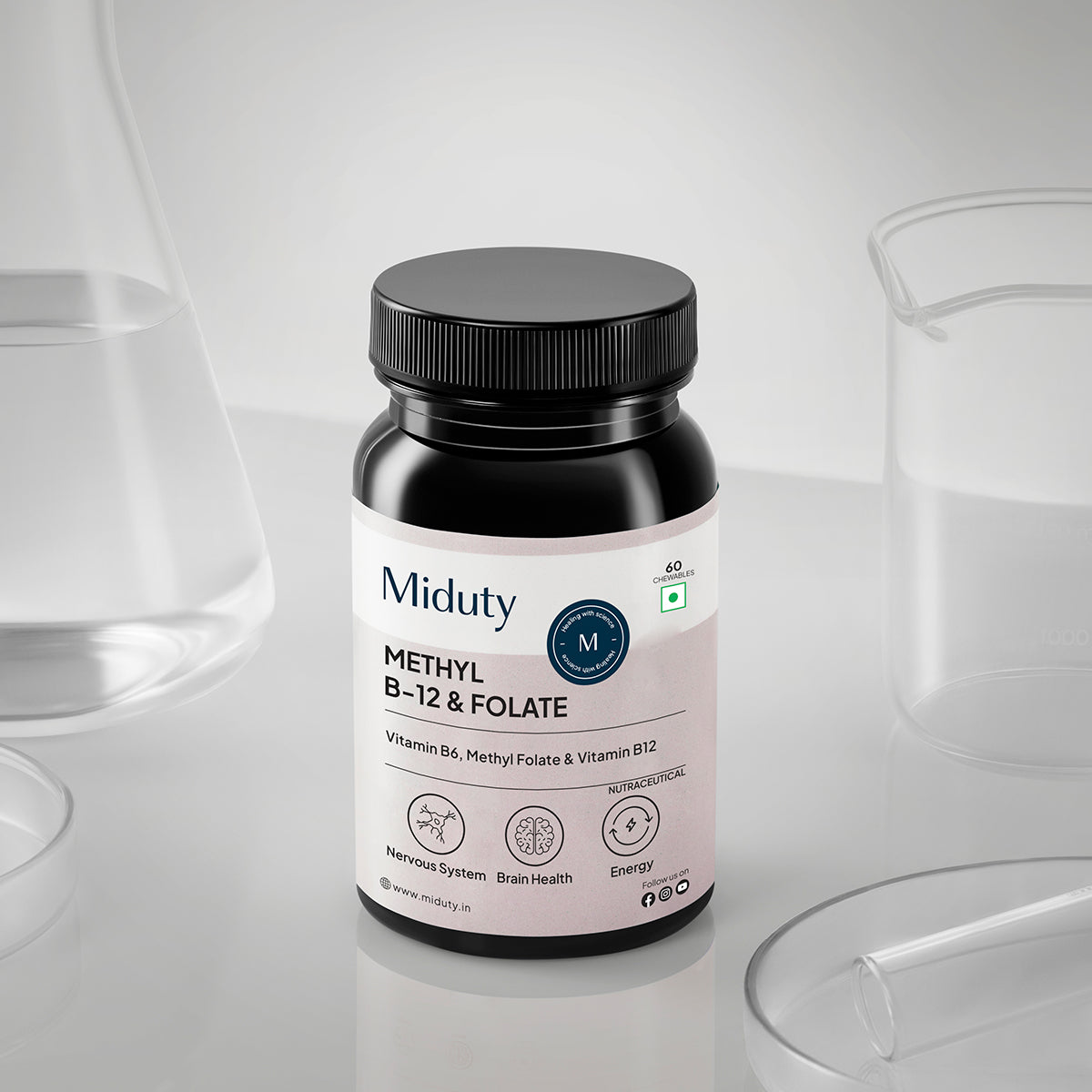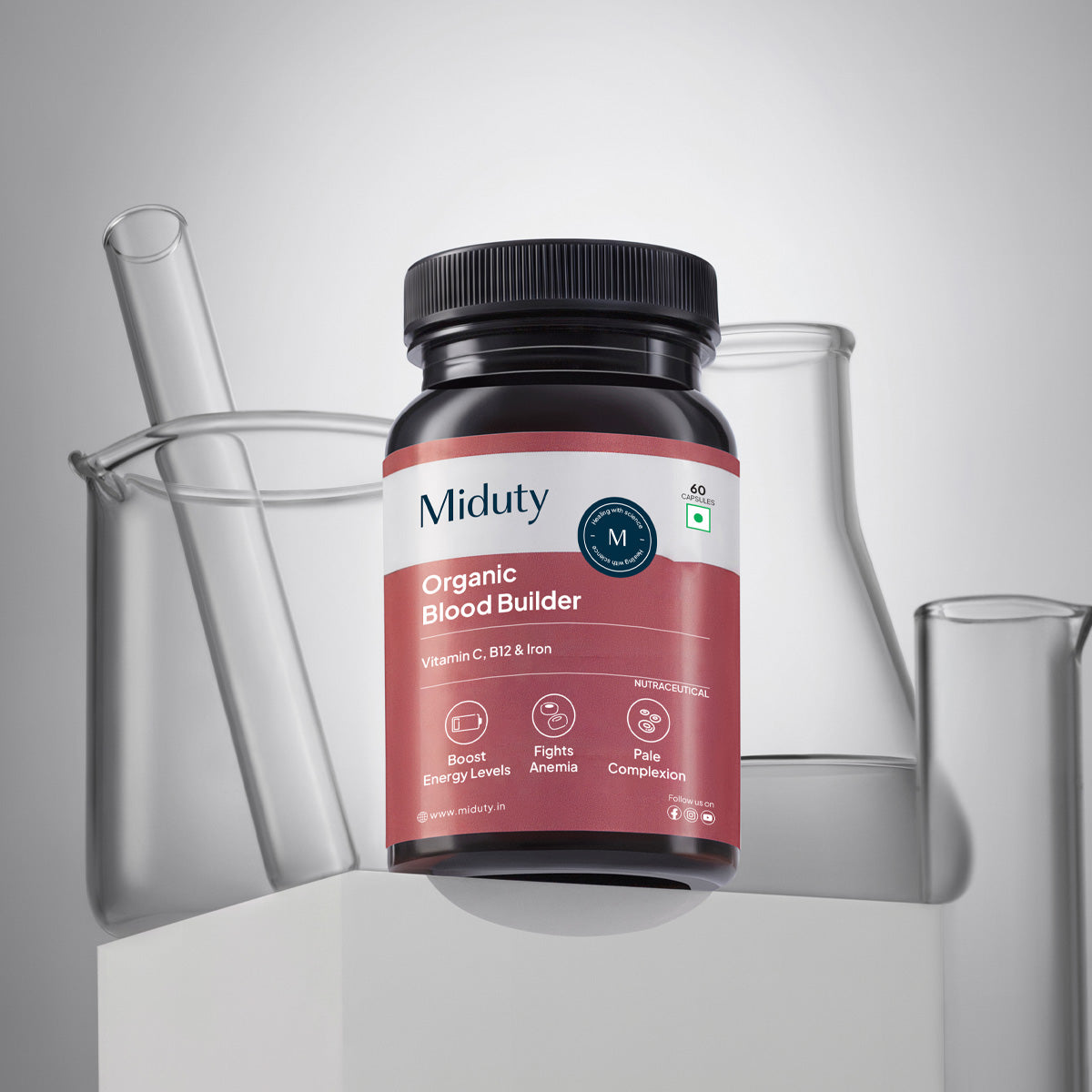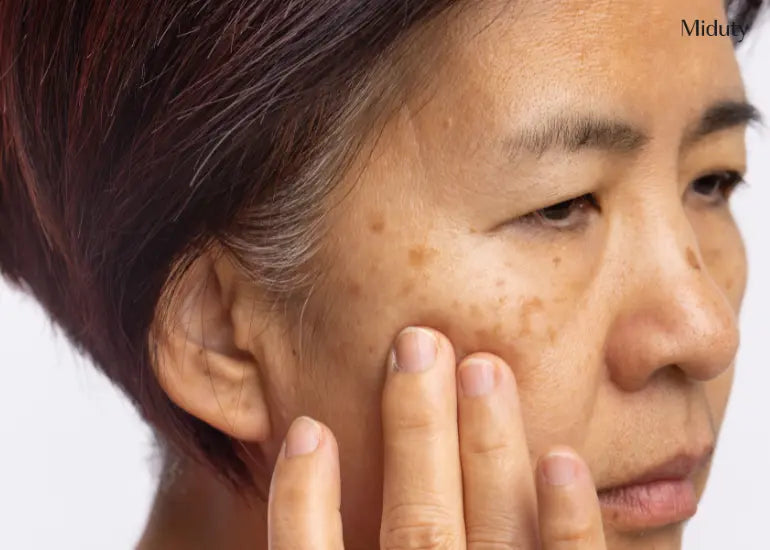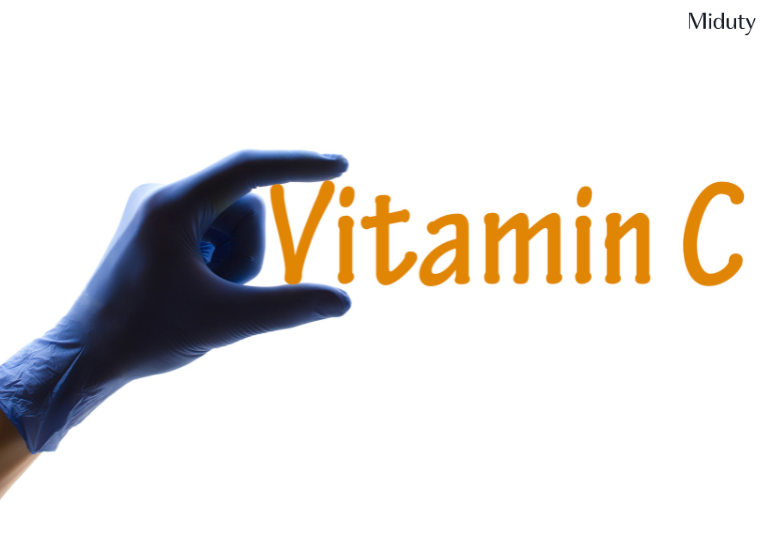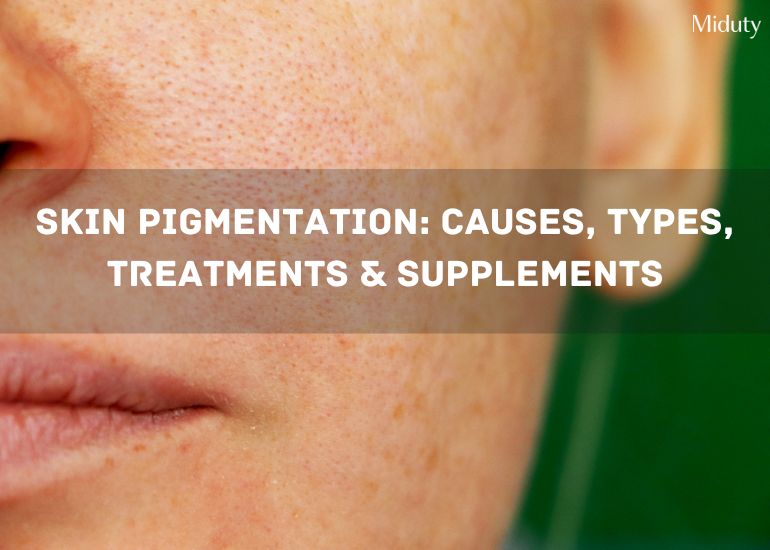
Skin Pigmentation: Causes, Types, Treatments & Supplements
Key Takeaways
1) What is Skin Pigmentation? It refers to the discoloration of skin because of melanin imbalance. There can be different types of skin pigmentation, including hyperpigmentation (excess melanin) and hypopigmentation (lesser melanin).
2) Types of Pigmentation Disorders: Based on two classes of skin pigmentation - hyperpigmentation and hypopigmentation, there are various types of this condition including melasma, freckles, albinism, vitiligo, and more.
3) Lifestyle Changes & Supplements as Skin Pigmentation Treatment: Adopting some simple lifestyle changes can make your pigmentation go away. Some of these habits are applying sunscreen daily, adding antioxidant-rich foods to the diet, not-so-harsh skincare regime, and hydration.
At some point in time, we all have noticed dark patches, uneven skin tone, or blotchy areas - especially on the face. It is so frustrating to see such changes popping up. There can be multiple reasons behind it such as excessive sun exposure, or stressful times. For some of you, these dark spots might be a reminder of your acne that doesn't seem to fade, while for some it might be sudden pigmentation because of hormonal shifts.
But you're not alone in this! The good news is, that there are many skin pigmentation treatments that you can go with to let go of this condition.
In this blog, we will talk about what skin pigmentation is along with the types of skin pigmentation disorders and the ways to treat the condition. You will be able to understand your skin better so that you can choose the right ways to regain your smooth, even-toned skin.
What is Skin Pigmentation?
Skin pigmentation refers to the natural pigment or color of our skin which is defined by melanin present in our skin cells. This pigment (melanin) is made by specific cells called melanocytes. The production of melanin in our skin cells is influenced by genetics, certain medical conditions, or sun exposure. [1]
Changes in the melanin pigment cause disorders related to it. In the cases where skin pigmentation becomes uneven or excessive in some areas of the skin, the condition is called hyperpigmentation. In some people, there might be less melanin production as well, resulting in hypopigmentation.
What Causes Skin Pigmentation?
Many of us believe that skin pigmentation on the face is solely due to sun exposure, but that's more of a myth! While sun exposure is a major factor, several other factors contribute to skin hyperpigmentation. In reality, skin pigmentation can be triggered by various internal and external factors that come in between melanin balance.
Identifying these triggers at the early stages can help in choosing the right skin pigmentation treatment. Some such causes of skin pigmentation include: [2]
|
Causes |
Description |
|
UV rays trigger melanin production in skin cells, leading to sun spots and skin pigmentation on the face or other body parts exposed to the sun. |
|
|
Skin inflammation can make your skin appear darker. People with darker skin tones tend to have hyperpigmentation more often after having inflammation. Inflammation may appear as acne, lupus, eczema, or any injury caused to the skin. |
|
|
Conditions like pregnancy, menopause, or thyroid dysfunction can also cause melasma and skin hyperpigmentation or hypopigmentation issues. |
|
|
A diet high in sodium, sugar, inflammatory foods, preservatives, or additives can also cause skin pigmentation on the face. |
|
|
As the skin ages, it becomes more susceptible to uneven skin pigmentation resulting in dark patches, or age spots. |
|
|
Certain medicines like antimalarial, and antidepressants, can also cause skin hyperpigmentation. In such cases, the spots or skin might appear grayish. |
|
|
Family history plays a role in the development of some types of skin pigmentation disorders such as freckles or vitiligo. |
Types of Skin Pigmentation Disorders & Their Treatments
Broadly, skin pigmentation on the face can be classified into two, which are:
Refer to the table below to learn about the different types of skin pigmentation and the respective skin pigmentation treatments. [3]
Hyperpigmentation
|
Disorder |
Causes |
Symptoms |
Treatment/Precautions |
|
Hormonal changes, sun exposure, pregnancy |
Light brown to gray-brown patches, typically on the face |
Use broad-spectrum sunscreen daily; avoid direct sun exposure; include Vitamin C-rich foods in your diet such as oranges, bell peppers, berries, broccoli, etc. |
|
|
Post-Inflammatory Hyperpigmentation |
Acne, injuries, or burns causing inflammation |
Dark spots after injury |
Avoid picking at pimples, have a soothing skincare regime with aloe vera; Use retinoids or hydroquinone to reduce the dark spots. |
|
Prolonged Sun Exposure |
Flat yellow to brown spots on areas exposed to the sun like face, arms, and hands. |
Wear hats and use SPF 30+ sunscreen, having zinc oxide and Non-nano titanium dioxide. Incorporate antioxidant-rich foods like green tea, berries, citrus fruits, etc. |
|
|
Freckles / Ephelides |
Genetic predisposition, sun exposure |
Red or tan to brown spots on sun-exposed areas |
May go away in winter; Use sunscreen regularly; Reduce sugar intake to minimize skin sensitivity |
|
Lichen Planus Pigmentosus (LPP) |
Linked to allergies or auto-immune conditions |
Dark, patchy discoloration often on the face, neck, or arms |
Take an anti-inflammatory diet (for example, include berries, turmeric, etc in your diet); Use Fragrance-free skincare products |
Hypopigmentation
|
Disorder |
Causes |
Symptoms |
Treatment/Precautions |
|
Autoimmune disorder causes loss of melanin |
White patches on the skin, usually asymmetrical |
Include Zinc-rich foods for melanin synthesis like seeds, almonds, legumes, etc.[4]; Use sunscreen to protect the pale areas |
|
|
Post Inflammatory hypopigmentation |
Skin Trauma from burns or surgery, psoriasis, or chemical peels |
Light patches of skin where trauma occurred |
Keep your skin well moisturized; avoid harsh skincare in the affected area; treat the underlying condition when needed. |
|
Albinism |
Genetics |
Very light skin, hair, and eyes; sensitive to sunlight |
Use UV-protected clothing and wear sunscreen; Avoid direct sun exposure |
|
Pityriasis Alba |
Eczema, dry skin, sun exposure, etc. |
Light, scaly patches on the face and arms, common in children |
Use gentle moisturizers; include omega-3 fatty acid-rich foods in your diet such as fish, chia seeds, walnuts, etc. |
Which Areas of Body and Face Are Prone to Pigmentation?
Area-wise pigmentation refers to the uneven darkening of specific parts of the face and body. It commonly appears due to factors like sun exposure, hormonal changes, friction, or post-inflammatory responses. Each area can have different underlying causes, making targeted care and treatment essential. For example:
1. Forehead: Often darkens due to sun exposure or hormonal changes. This area is frequently exposed to UV rays, making it more susceptible to sun-induced pigmentation. Stress and lifestyle factors can also contribute to dullness here.
2. Cheeks: Prone to hyperpigmentation from acne or melasma. Since cheeks have a higher concentration of sebaceous glands, breakouts are common, often leaving behind dark marks or persistent patches.
3. Upper Lip: Can darken from hormonal imbalance or hair removal. Frequent threading, waxing, or use of depilatory creams can cause irritation, leading to pigmentation over time. It's also a common site for melasma in women.
4. Chin: Pigmentation from acne scars is common. Hormonal breakouts often occur here, especially in adults, and repeated inflammation can result in post-inflammatory hyperpigmentation (PIH).
5. Neck: Darkening may result from friction or insulin resistance. Wearing tight collars or jewelry can cause irritation, while conditions like acanthosis nigricans may lead to velvety dark patches.
6. Underarms: Caused by shaving, friction, or deodorants. Constant rubbing and certain chemicals in deodorants may irritate the skin, triggering pigmentation. Poor ventilation and sweating can worsen it.
7. Elbows & Knees: Often dark due to dryness and dead skin buildup. These areas have thicker skin and fewer oil glands, leading to rough texture and accumulated pigmentation without regular exfoliation.
8. Back & Shoulders: Acne scars and sun exposure cause uneven tone. Pigmentation here often results from "bacne" and prolonged outdoor exposure without protection. Tight clothing and sweating can also aggravate it.
9. Hands: Sunspots and aging lead to pigmentation. As hands are constantly exposed and often neglected in skincare routines, dark spots and uneven tone become more noticeable with age.
10. Feet & Ankles: Often overlooked, pigmentation can result from friction or poor circulation. Wearing tight shoes, prolonged standing, or untreated wounds can lead to discoloration. Dry skin also contributes to uneven tone in these areas.
How to Treat Skin Pigmentation?
Skin pigmentation results from an overproduction of melanin, the pigment responsible for skin color. Thankfully, a combination of topical treatments, professional procedures, lifestyle changes, and nutritional support can help reduce and manage pigmentation effectively. Here's a breakdown of the most reliable treatment options:
1. Topical Treatments
Topical treatments are a foundational step in targeting pigmentation directly at the skin's surface. These products often inhibit melanin production or accelerate cell turnover to fade dark spots.
- Ryolis (Rucinol): A skin-lightening active that targets both tyrosinase and peroxidase enzymes involved in melanin synthesis, making it effective for treating stubborn pigmentation with fewer side effects. [7]
- Niacinamide: Reduces melanin transfer and strengthens the skin barrier, suitable for most skin types. [5]
- Kojic Acid: Derived from fungi, it blocks the enzyme tyrosinase, helping to lighten hyperpigmented areas. [6]
- Azelaic Acid: Treats both acne and post-inflammatory hyperpigmentation with minimal side effects.
- Retinoids: Promote cell turnover and fade pigmentation over time. Includes over-the-counter retinol and prescription-strength tretinoin. [8]
- Vitamin C: A brightening antioxidant that improves overall tone and reduces oxidative stress on the skin.
Consistent application (often for several weeks to months) and daily sun protection are crucial for optimal results. A serum containing both rucinol and niacinamide can be a suitable option for targeting pigmentation through multiple pathways.
2. Chemical Peels
Chemical peels exfoliate the outer layer of the skin, encouraging new, more evenly pigmented skin to emerge.
- Glycolic Acid: Penetrates deeply and is effective for mild to moderate pigmentation.
- Lactic Acid: A gentler option for sensitive skin, providing hydration while brightening.
- Salicylic Acid: Useful for oily or acne-prone skin, and helpful in fading pigmentation left behind by breakouts.
- TCA Peels: Medium-depth peels used in clinical settings to treat more stubborn pigmentation and sun damage.
Downtime varies depending on the depth of the peel. It's important to avoid sun exposure and follow aftercare instructions to prevent complications.
3. Laser Treatments
Lasers are highly effective for treating deeper or resistant pigmentation.
- Q-switched Nd:YAG Laser: Breaks down melanin in pigmented areas, allowing the body to naturally remove the pigment.
- Fractional Lasers: Stimulate collagen production while targeting uneven tone, helping with both pigmentation and texture.
- IPL (Intense Pulsed Light): Uses light pulses to target pigmented cells and can improve overall skin clarity.
These treatments usually require multiple sessions and should only be performed by trained professionals. They are not ideal for everyone, especially those with darker skin tones or sensitive skin, so consultation is essential.
4. Home Remedies
Home remedies can support skin health, though they are usually complementary to professional or topical treatments.
- Aloe Vera: Soothes irritation and may lighten dark spots over time.
- Licorice Extract: Helps inhibit melanin production naturally.
- Green Tea: Contains polyphenols that reduce inflammation and oxidative stress.
- Caution with DIY Ingredients: Lemon, turmeric, and raw potato are commonly recommended, but may irritate the skin if not used carefully.
5. Supplements
Addressing skin pigmentation internally can provide long-lasting improvements, complementing external treatments like creams and sunscreen. Nutritional supplements play a key role in supporting skin health by balancing melanin production and repairing damage.
- Omega-3 fatty acids, found in fish oil, flaxseeds, and walnuts, are excellent for reducing inflammation, strengthening the skin barrier, and improving overall texture. [9]
- Astaxanthin, an antioxidant, offers protection against oxidative stress and UV damage by acting as an internal sunscreen, helping to prevent the formation of dark spots.[10]
- Another very effective nutrient is N-acetyl cysteine (NAC), which enhances glutathione levels to brighten the skin and reduce pigmentation. [11]
- Resveratrol, sourced from red grapes, berries, and nuts, helps curb melanin overproduction, enhances skin tone, and provides antioxidant protection.
By incorporating these nutrients into your diet or supplement routine, you can take a proactive approach to achieve clearer and more radiant skin.
Skincare Routine to Prevent Skin Pigmentation
While treating skin pigmentation is possible, prevention is always better! Here are some tips to avoid pigmentation issues: [5]
1) Wear Sunscreen Daily: Choose a broad-spectrum sunscreen with an SPF of more than 30. Prefer using mineral sunscreens with Zinc Oxide and Non-nano Titanium Dioxide. Avoid the sun between 10 AM and 2 PM when the UV rays are at their peak.
2) Avoid Picking at Your Skin: Picking at spots, scabs, or acne can lead to inflammation, and thus Post-Inflammatory Hyperpigmentation or Hypopigmentation (PIH).
3) Use Gentle Skincare Products: Harsh skincare products can lead to irritation and inflammation making your skin pigmented.
4) Stay Hydrated and Eat Well: A balanced diet with antioxidant-rich foods like berries, leafy vegetables, etc. and enough water intake supports healthy skin.
5) Exfoliate Regularly: Regular exfoliation every week helps remove dead skin cells and increases cell turnover, thus, reducing the chances of skin pigmentation on the face or body.
Diet & Lifestyle Tips
Diet and lifestyle play a key role in managing skin pigmentation. Internal health often reflects on the skin, influencing its tone and clarity. Simple daily habits and routines can either support skin healing or contribute to pigmentation issues over time.
Foods to Avoid:
While a balanced diet supports healthy skin, some foods may aggravate pigmentation:
- Refined Sugar: Triggers inflammation, contributing to acne and post-inflammatory hyperpigmentation (PIH).
- High-Glycemic Foods: Foods like white bread and sugary drinks spike insulin, disrupting hormonal balance and stimulating excess melanin.
- Excess Salt: May lead to puffiness and poor skin circulation.
- Processed & Packaged Foods: These often contain preservatives and additives that worsen skin inflammation.
- Dairy (for some individuals): Linked to acne flare-ups, which can leave behind dark marks.
-
Fried and Greasy Foods: High in trans fats, they increase oxidative stress and dull the skin.
Foods to Eat for Clearer Skin:
To support pigmentation treatment from the inside out, consider including:
- Antioxidant-rich fruits: Berries, oranges, pomegranates help reduce oxidative stress.
- Leafy greens: Spinach and kale contain vitamins and minerals that support skin repair.
- Healthy fats: Avocados, nuts, and seeds provide essential fatty acids for skin health.
- Hydrating foods: Cucumbers, watermelon, and citrus fruits aid in detoxifying and hydrating the skin.
- Green tea: Both a topical and internal remedy for inflammation and pigment regulation.
Lifestyle Tips:
Simple daily habits can significantly influence skin health and help manage pigmentation over time, let's have a look.
- Get adequate sleep: Encourages skin repair and hormonal balance.
- Manage stress: Helps reduce inflammation and pigmentation triggers.
- Exercise regularly: Boosts circulation and supports natural detoxification.
- Limit screen time before bed: Improves sleep quality, aiding skin regeneration.
- Avoid smoking and excessive alcohol: Both accelerate skin aging and uneven tone.
Conclusion
Dealing with skin hyperpigmentation or hypopigmentation can feel frustrating, especially when those stubborn dark spots or uneven patches don't seem to go away easily. But the good news is that there are plenty of ways to treat and prevent pigmentation effectively. The key lies in understanding what skin pigmentation is, identifying the underlying cause, and adopting the right combination of skin pigmentation treatments and lifestyle adjustments.
From topical creams to simple lifestyle changes, such as just wearing sunscreen daily and maintaining a healthy diet with nutrients that may help your pigmentation. It's important to remember that skincare is not a one-size-fits-all journey. What might show results for someone else may take time for you, as every skin type reacts in different ways to treatments.
So, be patient and kind to your skin. Rushing through skin pigmentation treatments or trying harsh products may do more harm than good. Consistent changes in your lifestyle like keeping the skin well hydrated, having antioxidant-rich foods, and managing stress can support long-term improvement. And if the condition persists or worsens, consider consulting a dermatologist.
Skin health is not just about looking good, it's also about feeling comfortable in your skin.
Frequently Asked Questions on Skin Pigmentation
Q1 - Can skin pigmentation be cured?
While not all pigmentation can be permanently cured, many types can be effectively treated and visibly reduced.
Q2 - What causes skin pigment?
Skin pigmentation is mainly determined by melanin, a pigment produced by melanocytes. Several factors can affect melanin levels and distribution, causing changes in skin tone or the development of dark spots.
Q3 - What is the first stage of pigmentation?
In the early stage of pigmentation, mild discoloration appears and may be barely visible, causing slight unevenness in skin tone. As it progresses to the moderate stage, the spots become darker and more defined, making the pigmentation more noticeable and potentially affecting one's confidence.
Q4 - Does pigmentation fade naturally?
Some types of pigmentation can fade naturally over time, but the rate and extent depend on the underlying cause and individual skin factors. Post-inflammatory hyperpigmentation, such as marks from acne, often fades within months, whereas conditions like melasma tend to be more persistent and may need targeted treatment.
Q5 - What's the best treatment for skin pigmentation?
The best treatment for skin pigmentation depends on the type and cause but often includes a combination of topical actives (like retinoids or niacinamide), chemical peels, and lifestyle changes. For stubborn cases, laser therapy may be recommended by a dermatologist.
References


